 Written by Mike Price, OT
Written by Mike Price, OT
It can be difficult to know what to look for when it’s time to choose a hospital bed for home use. We asked four industry experts for their thoughts on how to go about choosing the best hospital bed, and they’ve shared their insights to help you shop hospital and home care beds.
For a comprehensive guide to help you decide which home hospital bed is best for you, read How to Choose a Hospital Bed for Home Use.
A senior-level sales leader at Invacare, Robert Hanley has more than 20 years of experience. Some of the questions to consider when determining the best choice for a hospital bed include the risk of a fall, weight capacity, pressure injury issues, ease of transporting the bed, and caregiver support needed.
“Ask yourself, ‘What functions does my hospital bed need for me or a loved one to be comfortable?’ ” noted Hanley. “That’s the most important question you can ask in the beginning steps to finding the right hospital bed.”
Hanley recommends making a list of key features needed before beginning a search for the best hospital bed for home care.
“Knowing how long you will need this bed is a vital piece of information when you’re in the market for a bed. This can help you choose between a manual, semi-electric, and full electric hospital bed,” he explained.
For those who are a fall risk, a low bed with side rails is a good choice to make getting in and out of bed easier with side rail assistance.
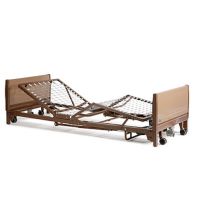 | Invacare Full Electric Homecare Hospital Bed View Product |
To view more top-selling products by Invacare, check out our Invacare Products Buying Guide.
Durable Medical Equipment expert at Drive Medical Josh Burke said the height and adjustability of the bed are important factors, as is choosing the correct mattress.
“Homecare beds come in three basic models: semi-electric, full-electric, and low full electric beds,” Burke said. “The No. 1 choice based on features and benefits would be the full-electric model. Both the semi-electric and full-electric bed will adjust the angle of the head and foot springs with the hand control but the full-electric bed will also raise and lower the height of the bed. This is an important feature if adjustments are needed regularly and the patient or caregiver may have difficulty adjusting the bed manually by using a hand crank.
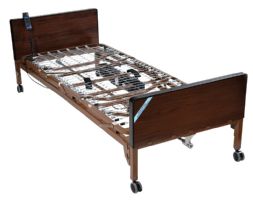 | Drive Medical Delta Ultra-Light 1000 Semi-Electric Bed View Product |
Burke said another factor when selecting a full-electric bed is the height itself. For both a semi and full-electric bed, the minimum height without casters is 12.75 inches, and the maximum height with casters is 21.5 inches.
“A low bed can go lower to the ground than any other model, featuring a minimum height of 9.5 inches without casters,” he explained. “This lower height setting can provide more peace of mind if the bed user is susceptible to falling out of the bed. A ‘fall mat’ can also be purchased and provided along with the full bed to minimize injury if falling out of the bed.”
He noted heights are very important when a patient is transitioning in and out of bed, whether with a transfer board or a patient lift. Also, patients may need to be raised or lowered when they are being cared for while in bed.
Burke also explained how choosing a mattress is equally as important as choosing the bed frame.
“Even more important than the bed you choose is the mattress you select to go on top of it,” he said. “Like any mattress, not just hospital bed mattresses, the selection is mainly based on preference and need. A standard innerspring or standard foam is going to be the most cost-effective, but would be the least comfortable. Adding the upgraded clinical foam mattress would be well worth the smaller upgrade cost. It creates a much more comfortable option (and higher weight cap of 350 lbs.), which also helps prevent the development of pressure ulcers.
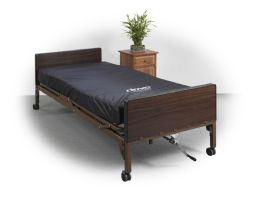 | Drive Medical Therapeutic 5 Zone Support Mattress View Product |
Drive Medical also carries Low Air Loss mattresses, which help to treat pressure ulcers. With all the mattress choices, there are good, better, and best options with more features and longer warranties.
“Besides the mattress and the bed rails, there are many other complimentary items that go along with the bed to enhance the patient’s quality of life,” Burke said. “You have a ‘Bed in a Box’ which comes with a fitted sheet, flat sheet, blanket, and pillowcase. Hospital beds are an odd size so standard bed sheets do not fit them well.”
Burke mentioned utilizing an overbed table like the kind used in hospitals to make it easier to take meals, or a reacher to help grab hard-to-reach items.
“We also offer bed wedges to help with positioning, or urinals to assist with bathroom needs,” he added. Burke provided a lot of useful information and invites readers to check out the Drive Medical Equipment Buying Guide.
Brian Roth is the Vice President of Marketing and Sales for Med-Mizer, and he said the first thing to determine when choosing a hospital bed is how will the user safely enter and exit the bed.
“When aging in place, the most common struggle reported from our home care customers is the difficulty they experience when entering or exiting a hospital bed,” Roth said. “Adding to their difficulty, many of these customers have a condition, illness, or limitation, which makes this process even more challenging.”
Not only is this a challenge for the individual using the bed, but the spouse, loved one, or other caregiver is at risk for injury when helping them get in and out of bed.
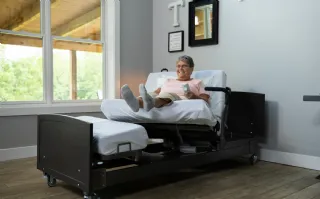 | ActiveCare Rotating Pivot Lift-Assist Bed by Med-Mizer View Product |
“The ActiveCare Bed was specifically designed to give individuals the ability to safely enter and exit the bed, within the comforts of their own home,” Roth explained. “This fully automated innovation is the only bed manufactured in the US that turns to the side and sits the end-user into a full chair position with the touch of one button – using the built-in stand assist (high/low control), the end-user can raise or lower the bed to a comfortable safe transfer height.”
Roth additionally emphasized how important it is to determine fall risks, and to have solutions in place to prevent accidents.
“Over time, many have become acclimated to sleeping on a queen or king-sized surface, and with the majority of hospital beds being a much narrower 35 to 36-inch width, some have accidentally rolled out of bed as a result of the narrower surface,” he said.
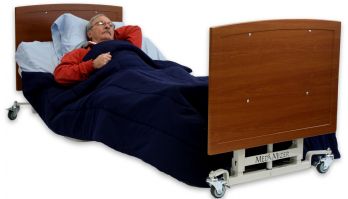 | AllCare Floor Bed by Med Mizer View Product |
The AllCare Bed has a 3.6” low height, which reduces the risk of impact or injury due to a fall from a standard height hospital bed, turning it into a roll instead. Using our Comfort Wide sleep surface, the bed can be widened to a 42-inch width to ensure the user is safer while lying in this lower, wider bed.
Med-Mizer has innovated solutions that encompass all the functionality required to age in place safely and independently, without having to sacrifice the aesthetic comfort that your home can provide.
“The SelectCare bed combines advanced positioning options with the clinical features of a specialty hospital bed, while maintaining the aesthetic comfort of your home with its premium wood package,” Roth said.
To learn more about all the different home hospital beds Med-Mizer offers, read Innovative Adjustable Hospital Beds by Med-Mizer, and Shop Med-Mizer Products.
The Director of Product Management at Joerns Healthcare, Jim Mulligan said something to consider is whether you want to use the same equipment you enjoyed at a medical facility, something straightforward for home use, or something with a little more room to reposition while in bed.
“Long term care styled low-beds offer the most comfort positions, durability, and peace of mind when caring for a loved one - especially those with chronic care needs,” Mulligan said. “Plus, those same beds used in medical facilities are available for use in the home for the ultimate in injury prevention and adjustability. Low-beds typically offer more fall prevention than conventional homecare beds by lowering to 7” reducing the risk of injury during a fall.”
The most popular low bed at Joerns is the Joerns EasyCare Three Function Healthcare Bed System. With a long history of servicing long-term care and homecare customers with quality long-lasting products, Joerns is focused on safety and injury prevention.
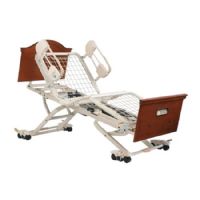 | Joerns EasyCare Three Function Healthcare Bed System View Product |
Need easier access to home, some low-beds split into two pieces for easy delivery or storage when not being used. Low-beds also offer many accessories to accommodate different size people or allow for more room side to side. Most hospital beds are only 35” wide, more narrow than a twin bed. Adding width options to the bed for 42” width adds room for repositioning and makes the bed feel larger than a King bed! Don’t forget to pick assist handles for better handholds when exiting/entering the bed.
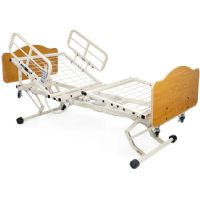 | Joerns WeCare Full-Electric Hospital Bed View Product |
Mulligan noted Joerns offers comfort and confidence in your purchase while offering a full suite of products including Hoyer, the leading name in patient handling, PrevaMatt foam mattresses, and the ultimate in air therapy the Dolphin Fluid Immersion Simulation marrying our longstanding UltraCare bed with FIS integrated therapy system.
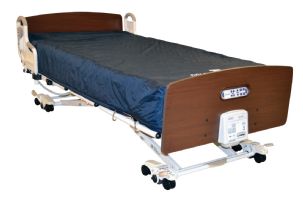 | DolphinCare Fluid Immersion Simulation FIS Integrated Bed System View Product |
To see top-selling products by Joerns, read our brand guide Joerns Healthcare Buying Guide | Beds and Lifts to Make Sleeping Easy.
Choosing the best hospital bed for home use is a big decision that can have a huge impact on the user’s quality of life.
Thank you for reading this article, and special thanks to our contributing experts for sharing their insights to assist our readers in making the best purchasing choice!
For everything you need to know about buying the right hospital bed and mattress, read our Ultimate Guide to Hospital Beds & Mattresses for Home Care. You can also visit Caregiver University for more information and resources.

Co-Founder of Rehabmart and an Occupational Therapist since 1993. Mike has spent his professional career working in multiple areas of Occupational Therapy, including pediatrics, geriatrics, hand therapy, ergonomics and inpatient / outpatient rehabilitation. Mike enjoys writing articles that help people solve complex therapeutic problems and make better product choices.